I used GEKKO to estimate the states online given perturbed observation states.
But I have two problems:
- solution is not found for setting window_size* > 40 ex) raise Exception(apm_error) Exception: @error: Solution Not Found
- using window_size*<40 the solver works, but filtering is not working properly for noisy observed data. ex) red dotted line: estimated state, black line: true state, green x: observed state
*'window_size' is the variable setting the length of the time window of MHE. For detailed use, refer to my code below.
Studying the MHE code example, I found out that what I am trying to do is a little different from the example: Example estimates the states given all the data at once. I want to estimate every time step, receiving the observed data online and estimating the true state. That is, I expect to attain estimated states which aligns with the true state(black line in figure above)
So I made a 'make_buffer' function for updating the observed, control data with a size of time_window. I used this buffer to estimate new states given observed states. I used the last element of the estimated states to plot the results. However, I am not sure if I am implementing the MHE in the right way. Or do I need to use another method for what I want to do?
I tried increasing WMODEL expecting that the estimated results will smoothen, but changing this parameter doesn't seem to make any change :(
My code:
from gekko import GEKKO
import numpy as np
import matplotlib.pyplot as plt
import matplotlib; matplotlib.use('TkAgg')
import time
import os
class Observer():
def __init__(self, true_sigma, window_size):
self.window_size = window_size
self.r_sigma_list = np.zeros(window_size)
self.alpha_sigma_list = np.zeros(window_size)
self.dt = 0.05
self.t_data = [i*self.dt for i in range(window_size)]
self.count = 0
self.true_sigma = true_sigma
self.estimation_error = 0
self.tolerance = 0
def make_buffer(self, observed_state, u_data): # start with 1 data and stack to window_size
if self.count == 0:
self.observed_states = observed_state
self.u_datas = u_data
elif self.count > 0 and self.count < self.window_size:
self.observed_states = np.vstack([self.observed_states, observed_state])
self.u_datas = np.append(self.u_datas, u_data)
else:
self.observed_states = np.roll(self.observed_states, -1, axis=0)
self.observed_states[self.window_size -1] = observed_state
self.u_datas = np.roll(self.u_datas, -1)
self.u_datas[self.window_size -1] = u_data
self.count += 1
def MHE(self, observed_state, u_data):
self.make_buffer(observed_state, u_data)
print('count: {}'.format(self.count))
if self.count < 2:
self.r_sigma = 0
self.alpha_sigma = 0
# return observed_state[0,0], observed_state[0,1], self.r_sigma, self.alpha_sigma # for online running: states are tensor
return observed_state[0], observed_state[1], self.r_sigma, self.alpha_sigma # for offline running
r_data = self.observed_states[:,0]
# print('r_data: {}'.format(r_data))
alpha_data = self.observed_states[:,1]
# print('alpha_data: {}'.format(alpha_data))
self.m = GEKKO(remote=False)
self.m.time = self.t_data[:self.count]
# print('self.m.time: ',self.m.time)
self.m.r = self.m.CV(value=r_data, lb=0) #ub=20 can be over 20
self.m.r.STATUS = 0
self.m.r.FSTATUS = 1 # fit to measurement
self.m.r.WMODEL = 20.0
self.m.r.WMEAS = 10.0
self.m.alpha = self.m.CV(value=alpha_data)
self.m.alpha.STATUS = 0
self.m.alpha.FSTATUS = 1
self.m.alpha.WMODEL = 20.0
self.m.alpha.WMEAS = 10.0
# print('u_datas: ', self.u_datas)
# u = self.m.MV(value=self.u_datas, lb=-2.3, ub=2.3) #MV = FV: 0.12 error ~ SV with no status setting = CV: 0.16 error
self.m.u = self.m.MV(value=self.u_datas)
self.m.u.STATUS = 0 # optimizer doesn't adjust value
self.m.u.FSTATUS = 1 #default
self.m.Equations([self.m.r.dt()== -self.m.cos(self.m.alpha), self.m.alpha.dt()== self.m.sin(self.m.alpha)/self.m.r - self.m.u]) # differential equation
self.m.options.IMODE = 5 # dynamic estimation
self.m.options.EV_TYPE = 2 #Default 1: absolute error form 2: squared error form
self.m.options.NODES = 5 # collocation nodes
# r.MEAS_GAP = 0.1 # MEAS_GAP = dead-band for measurement / model mismatch #used for EV_TYPE = 1
# alpha.MEAS_GAP = 1
# try:
self.m.solve(disp=False) # display solver output
# self.r_sigma = np.sqrt(np.sum(np.square(r_data - self.m.r.value))/(self.window_size -1)) #MSE bessel's correction needed: since r.value is estimate?
# print('r_data - r.value = {} - {} = {}'.format(r_data, self.m.r.value, r_data-self.m.r.value))
# self.alpha_sigma = np.sqrt(np.sum(np.square(alpha_data - self.m.alpha.value))/(self.window_size -1))
# except:
# print('solution not found')
return self.m.r.value[-1], self.m.alpha.value[-1], self.r_sigma, self.alpha_sigma
if __name__=="__main__":
FILE_PATH00 = '/home/shane16/Project/model_guard/uav_paper/adversarial/SA_PPO/src/DATA/estimation_results_r.csv'
FILE_PATH01 = '/home/shane16/Project/model_guard/uav_paper/adversarial/SA_PPO/src/DATA/estimation_results_alpha.csv'
FILE_PATH02 = '/home/shane16/Project/model_guard/uav_paper/adversarial/SA_PPO/src/DATA/action_buffer_eps0.0_sig1.0.csv'
x = np.arange(1,301) # 1...300
matrix00 = np.loadtxt(FILE_PATH00, delimiter=',')
matrix01 = np.loadtxt(FILE_PATH01, delimiter=',')
matrix02 = np.loadtxt(FILE_PATH02, delimiter=',')
# vanilla model true/observed states
r_vanilla_sigma_1_true = matrix00[18, 3:]
r_vanilla_sigma_1_observed = matrix00[19, 3:]
alpha_vanilla_sigma_1_true = matrix01[18, 3:]
alpha_vanilla_sigma_1_observed = matrix01[19, 3:]
vanilla_estimation_matrix_r = np.zeros(300)
vanilla_estimation_matrix_alpha = np.zeros(300)
# u_data
vanilla_action_sigma_1 = matrix02
# initialize estimator
sigma = 1.0
window_size = 10
observer = Observer(sigma, window_size)
for i in range(300):
vanilla_observed_states = np.hstack((r_vanilla_sigma_1_observed[i], alpha_vanilla_sigma_1_observed[i]))
# print('vanilla_observed_states: ', vanilla_observed_states)
r_hat, alpha_hat, estimated_r_sigma, estimated_alpha_sigma = observer.MHE(vanilla_observed_states, vanilla_action_sigma_1[i])
vanilla_estimation_matrix_r[i] = r_hat
vanilla_estimation_matrix_alpha[i] = alpha_hat
# #------------------- save estimated_states as csv ------------------------------------
# save estimated_r
plt.figure()
plt.subplot(3,1,1)
plt.title('Vanillla model_sig1')
plt.plot(x, vanilla_action_sigma_1,'b:',label='action (w)')
plt.legend()
plt.subplot(3,1,2)
plt.ylabel('r')
plt.plot(x, r_vanilla_sigma_1_true, 'k-', label='true_r')
plt.plot(x, r_vanilla_sigma_1_observed, 'gx', label='observed_r')
plt.plot(x, vanilla_estimation_matrix_r, 'r--', label='time window: 50')
# plt.legend()
plt.subplot(3,1,3)
plt.xlabel('time steps')
plt.ylabel('alpha')
plt.plot(x, alpha_vanilla_sigma_1_true, 'k-', label='true_alpha')
plt.plot(x, alpha_vanilla_sigma_1_observed, 'gx', label='observed_alpha')
plt.plot(x, vanilla_estimation_matrix_alpha, 'r--', label='time window: 50')
# plt.legend()
plt.savefig('offline_test_estimated_std1_vanilla_window50.png')
plt.show()
csv files: https://drive.google.com/drive/folders/1mdTkM4kyysYVpXDdRoUE1DMQWEgt-CDQ?usp=sharing
Could you please help me figure this out? Thanks for your help in advance.
Sincerely, from Shane K.


